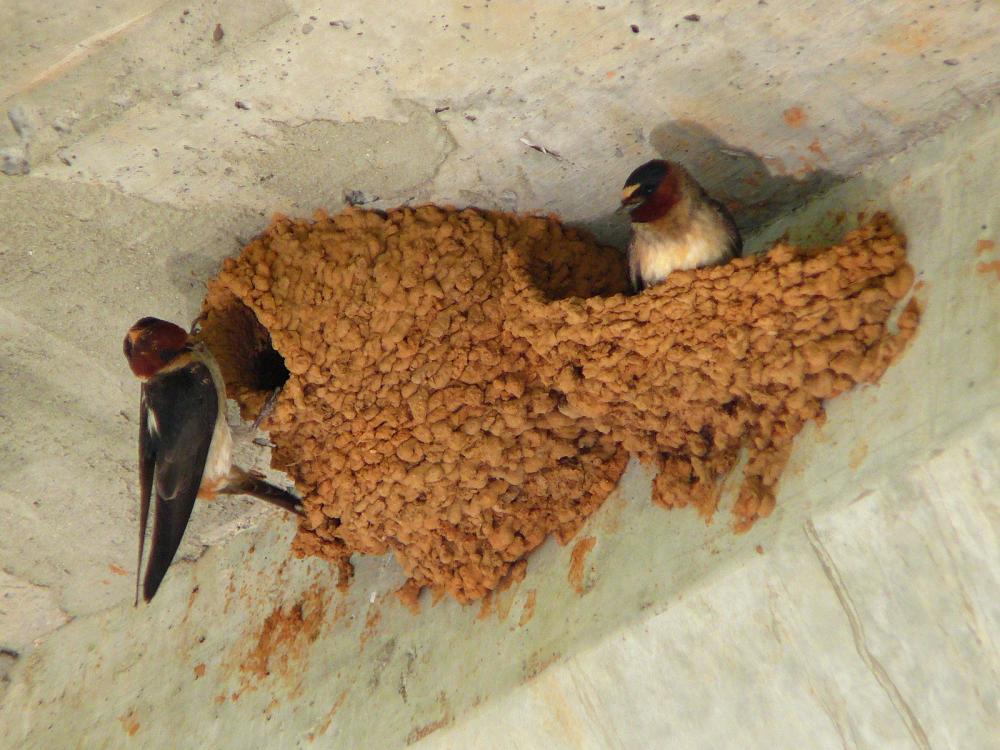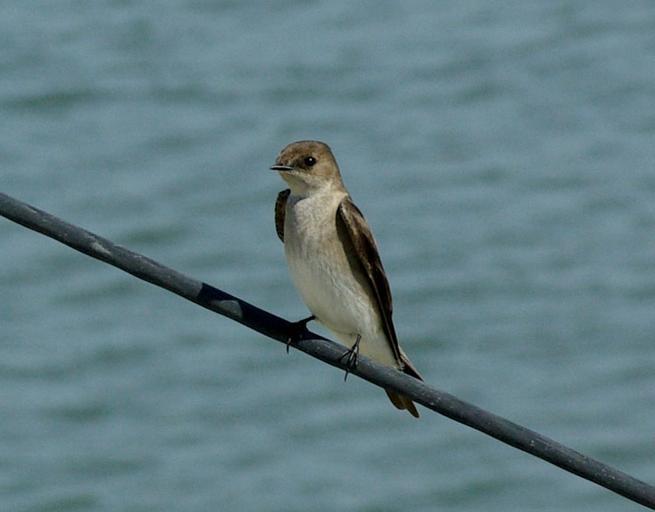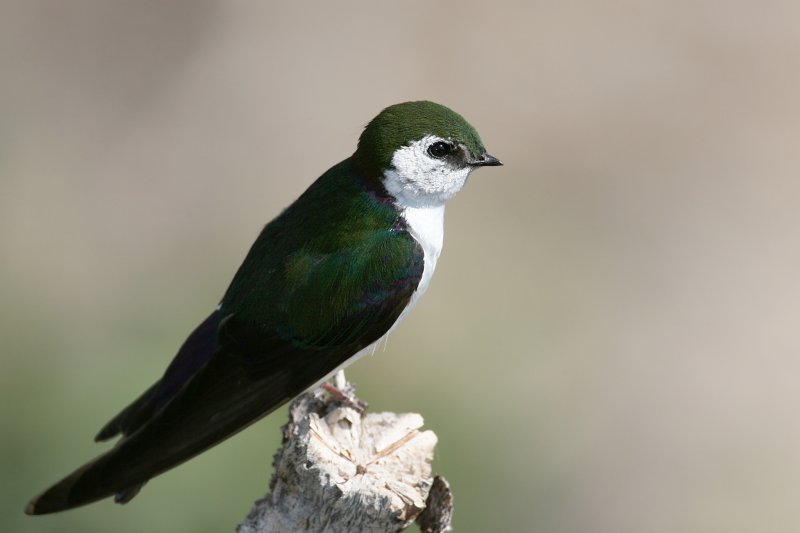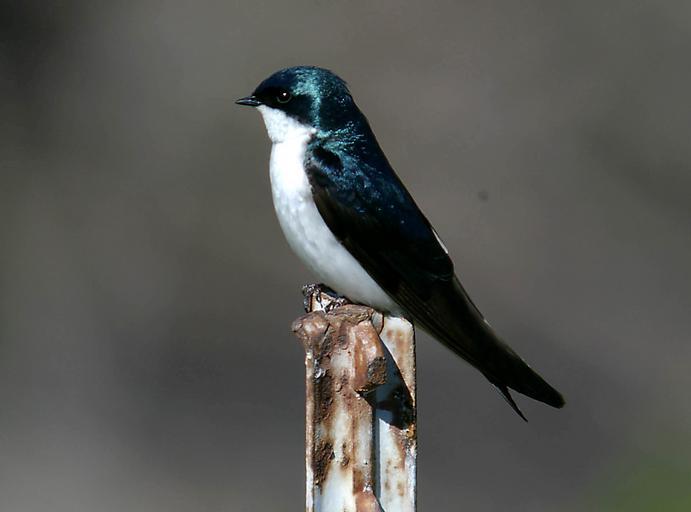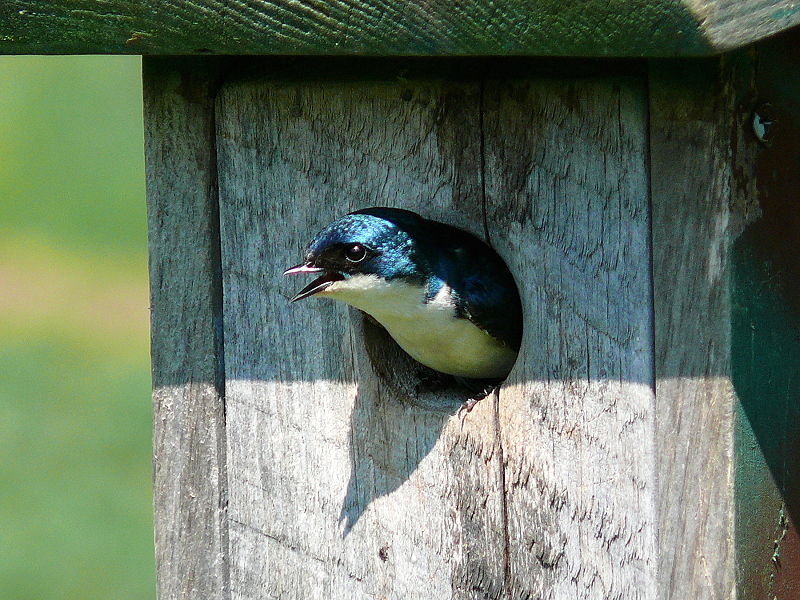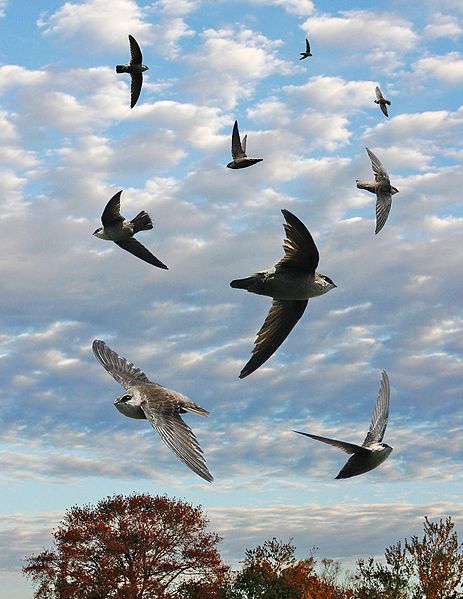eOrganic authors:
Olivia M. Smith, School of Biological Sciences, Washington State University
William E. Snyder Ph.D., Department of Entomology, Washington State University
This is one in a series of three articles about insectivorous birds on organic farms. The other articles are:
Introduction
A growing body of experimental evidence suggests that birds play important roles as natural enemies in agricultural ecosystems. For example, a study conducted in Europe demonstrated the important services provided by Great Tits (Parus major) in apple orchards. Researchers experimentally added nest boxes to some plots and saw an increase in fruit yield from 4.7 to 7.8 kg per tree. Increased yield was attributed to predation of caterpillars by Great Tits (Mols et al., 2002). A review paper by Bael et al. (2008) found that across 48 studies examined, birds reduced arthropods and plant damage. Here we focus on identification, diet, and management of swallows and swifts observed on West Coast organic vegetable farms and discuss their natural pest control services.
- Barn Swallow
- Cliff Swallow
- Northern Rough-winged Swallow
- Violet-green Swallow
- Tree Swallow
- Vaux's Swift
Barn Swallow (Hirundo rustica)
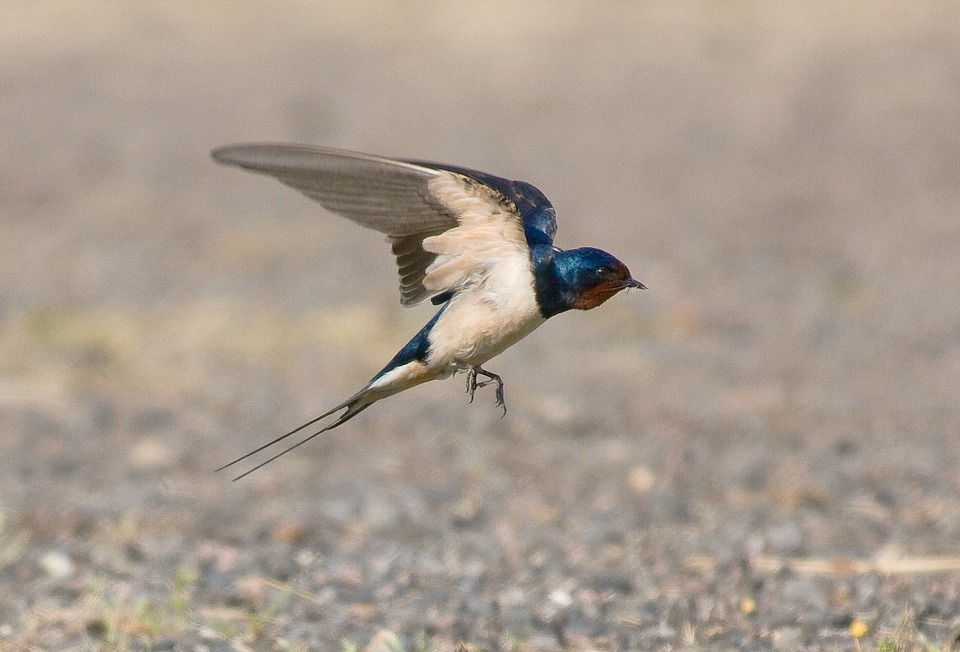
Figure 1. Adult Barn Swallow in flight. Note the long tail streamers which set it apart from other adult swallows. Photo credit: Denise Coyle, Barn Swallow.
Identification
Barn Swallows (Fig. 1) are the most abundant swallow species in the world (Fig. 2; Brown and Brown, 1999) and are present on many farms globally (Kragsten et al., 2009). They are most easily distinguished from other swallows by their long, forked tails which are used for stability during their daring aerial acrobatics (Norberg, 1994). These swallows have blue backs, buffy breasts and bellies, and orange throats and foreheads.
Figure 2. Range map for the Barn Swallow. [Image provided by eBird (www.ebird.org) and created 4 March 2017]
Diet
Barn Swallows primarily eat flying insects; in fact, approximately 99.8% of their diet is animal matter. Thermals and convection currents occasionally lift ground insects to an altitude where swallows can consume them (Brown and Brown, 1995). Barn Swallows may be able to significantly reduce crop pest insect populations. For example, a study conducted in Poland (Orlowski et al., 2014) analyzed Barn Swallow nestling faecal sacs and found that 17.8% of the nestling diet was oilseed rape pests, with an additional 5.3% being other arable crop pests. Flies are a preferred food, including horse flies, crane flies, and robber flies. Stinkbugs, leafhoppers, and plant lice are also common prey. Less commonly eaten are ants, bees, parasitic wasps, predaceous ground beetles, ladybird beetles, weevils, dung beetles, and dragonflies. Caterpillars are rarely consumed due to the Barn Swallow's aerial foraging strategy (Beal, 1918). Open areas such as pastures and plowed fields are preferred for foraging. Barn Swallows can often be observed dutifully foraging for pesky insects behind tractors as fields are plowed and planted.
Management
Barn Swallows are one of the few bird species that have benefited from European settlement (Brown and Brown, 1999), but results from the North American Breeding Bird Survey indicate a 1.1% range-wide decline in North American populations from 1966-2012 (Sauer et al., 2014). Similarly, Barn Swallow populations have declined in Europe. The declines are largely attributed to increased pesticide usage, reduction of livestock grazing, reduction of on-farm ponds, and reduction of semi-natural habitats on farmlands (hedgerows, etc.). These changes have resulted in decreased invertebrate abundance and diversity, reducing food availability for adult and nestling swallows (Evans and Robinson, 2004; Kragsten et al., 2009).
As their name implies, Barn Swallows often nest in groups in rafter beams of barns in open cup mud nests (Fig. 3). Some growers will add narrow wooden ledges to walls or under eaves to provide nesting space. Nest removal at the end of the breeding season can help prevent buildup of ectoparasites (Brown and Brown, 2015). Detailed instructions on building and placing nests for native species can be found at the Cornell Lab of Ornithology's website nestwatch.org. However, care must be taken in nest placement because Barn Swallows can be pests when they nest above food processing areas and drop feces. Barn Swallows can vector verocytotoxin-producing Escherichia coli when living in close proximity to livestock operations, although previous studies suggest it is rare (< 2%; Nielsen et al., 2004). Barn Swallows may be exposed after consuming flies that have associated with livestock feces (Hancock et al., 1998). Many growers attempt to discourage nesting using metal spikes in open rafters.

Figure 3. Barn Swallow open cup mud nest. Photo credit: Hans Schwarzkopf, Swallows
Cliff Swallow (Petrochelidon pyrrhonota)
Figure 4. Cliff Swallows nest building. Note the buffy forehead patch that distinguishes them from Barn Swallows. Also note the enclosed top on the finished nest on the left, a trait that distinguishes Cliff Swallow nests from open cup Barn Swallow nests. Photo credit: Ken Thomas, Cliff Swallows
Identification
Cliff Swallows are another widespread swallow species similar in appearance to Barn Swallows but lack long tail streamers (Fig. 4; Fig. 5). Cliff Swallows also have a distinct white forehead patch. Nests appear similar to the Barn Swallow but are enclosed rather than open cup (Fig. 3; Fig. 4). Nests are often placed in the eaves of barns.
Figure 5. Range map for the Cliff Swallow. [Image provided by eBird (www.ebird.org) and created 4 March 2017]
Diet
The Cliff Swallow diet is almost entirely animal matter, with less than 1% comprised of vegetable matter. A study across the United States found that beetles were the most common food item of the Cliff Swallow, with 2.67% of the total diet being beneficial beetles such as the ladybird beetle. Like the Barn Swallow, ground beetles are typically not eaten due to the Cliff Swallow's aerial foraging habits. Other common prey include weevils, ants, bees, parasitic wasps, and flies (Beal, 1918). A diet analysis of nestlings found that grasshoppers were the primary food delivered to nestlings, but food came from 84 insect families. While Barn Swallows primarily catch single large-prey items at low altitudes (< 10 m), Cliff Swallows catch many small swarming insects at high altitudes (50 m) (Brown and Brown, 1996). Cliff Swallows commonly forage in open fields and pastures.
Management
Like the Barn Swallow, Cliff Swallows have largely benefited from European settlement (Brown and Brown, 1995), and results from the North American Breeding Bird Survey indicate a 0.4% range-wide increase from 1966-2012 (Sauer et al., 2014). Nest removal at the end of the breeding season can help prevent buildup of ectoparasites (Brown and Brown, 2015). Removal of nests in the fall can also prevent invasive House Sparrows from outcompeting Cliff Swallows. House Sparrows can roost in the nests throughout the winter and establish broods before Cliff Swallows return from migration. House Sparrow removal has been shown to be effective at increasing numbers of Cliff Swallows (Buss, 1942; Samuel, 1969; Krapu, 1986). Instructions on deterrence and removal of House Sparrows can be found here. Like the Barn Swallow, installing wooden ledges can help with nest stability.
Northern Rough-winged Swallow (Stelgidopteryx serripennis)
Figure 6. Northern Rough-winged Swallow. Note the buffy color on the flanks. Photo credit: Alan Schmierer, Northern Rough-winged Swallow, CC0 1.0 Universal
Identification
This swallow is a wide-ranging and fairly drab species that is often missed or confused with juveniles of other swallows (Fig. 6; Fig. 7). The plumage is brown on the head, nape, back, and tail and buffy white on the throat, breast, and belly. The most distinguishing feature from similar swallows is that the chest and sides have some brownish gray rather than being solid white. The species' common name comes from the rough edge on outer primary feathers (flight feathers) (De Jong, 1996).
Figure 7. Range map for the Northern Rough-winged Swallow. [Image provided by eBird (www.ebird.org) and created 4 March 2017]
Diet
The Northern Rough-winged Swallow's diet is about 99% insect matter. A gut content analysis found flies comprised approximately 33% of the annual diet; beetles comprised 15% of the annual diet; true bugs such as stink bugs, tree hoppers, and leafhoppers comprised 15% of the annual diet; and ants comprised 12% of the annual diet. Caterpillars, moths, grasshoppers, dragonflies, and spiders comprised less than 5% of the annual diet each (Beal, 1918). The Northern Rough-winged Swallow forages at lower altitudes and above water more often than other swallow species (DeJong, 1996).
Management
Results from the North American Breeding Bird Survey indicate a 0.4% range-wide decrease from 1966-2012, and declines were primarily in the northern and western parts of its range (Sauer et al., 2014). Northern Rough-winged Swallows occasionally nest in old Cliff Swallow nests but more often nest on bridges or in burrows in cliffs, ledges, and banks dug out by other species (Beal, 1918; DeJong, 1996). Like the Cliff and Barn Swallow, human development has increased usable nesting space. One study found that most Northern Rough-winged Swallow nests (54%, n = 224) were found in human created structures such as railroad cuts, landfills, and gravel pits (Campbell et al., 1997).
Violet-green Swallow (Tachycineta thalassina)
Figure 8. Violet-green Swallow. Note the white color that extends around the eye that distinguishes it from the similar Tree Swallow. Photo credit: Wolfgang Wander, Violet-green-swallow, CC BY-SA 3.0
Identification
As the name implies, Violet-green Swallows have green upper parts with violet upper-tail coverts and wings. They closely resemble the Tree Swallow, but the Violet-green Swallow has a shorter tail, white that extends around the eye, and a white patch on each side of the rump that is highly visible in flight (Fig. 8). The Violet-green Swallow is abundant in montane coniferous forests, and less widespread than the similar looking Tree Swallow (Fig. 9; Fig. 11; Brown et al., 2011).
Figure 9. Range map for the Violet-green Swallow. [Image provided by eBird (www.ebird.org) and created 4 March 2017]
Diet
The Violet-green Swallow almost exclusively eats flying insects. Common food items are leafhoppers, leaf bugs, flies, ants, wasps, bees, and beetles (Bent, 1942). True bugs and beetles are likely consumed primarily when convection currents bring them up into the Violet-green Swallow's foraging range (Brown et al., 2011).
Management
Results from the North American Breeding Bird Survey indicate a 0.4% range-wide decrease from 1966-2012 (Sauer et al., 2014). This species is a tree cavity nester, so conserving and restoring copses of trees will help provide for their nesting requirements. This species will also use nest boxes placed near fields, trees, or cliffs. Nesting locations are often a limiting resource, so providing nest boxes can be important for attracting cavity nesting insectivores. Instructions on building and placing swallow nest boxes can be found here and here. Additionally, many businesses sell pre-made boxes designed for swallows. Nest boxes should be cleaned out every year. Like with Cliff Swallows, introduced House Sparrows can outcompete Violet-green Swallows for nest space or destroy their eggs. Removal and deterrence of sparrows can aid in successful rearing of swallow chicks (Edson, 1943).
Tree Swallow (Tachycineta bicolor)
Figure 10. Tree Swallow. Note the more iridescent bluish hue and the bluish color that extends below the eye. Photo credit: Alan Schmierer, Tree Swallow, CC0 1.0 Universal
Identification
Tree Swallows are a widespread species with iridescent blue on their head, nape, back, tail coverts, and wing coverts (Fig. 10; Fig. 11). The wings fade into dark gray. The throat, breast, and belly are white. The tree swallow lacks the distinct white tail coverts of the Violet-green Swallow, and the white on the face ends below the eye.
Figure 11. Range map for the Tree Swallow. [Image provided by eBird (www.ebird.org) and created 4 March 2017]
Diet
This species eats more vegetable matter than other swallow species. An early study conducted by Beal (1918) on swallow gut content found vegetable matter was about 20% of contents and was present in the diet throughout the breeding season. Diptera (flies) form the largest portion (about 40%) of the adult Tree Swallow diet, including crane flies, horse flies, and syrphid flies. Beetles comprised 14% of the diet. Dung beetles, weevils, ants, bees, parasitic wasps, dragonflies, and spiders comprised less than 5% of the diet. Tree Swallows also ate pests including aphids, stink bugs, tree hoppers, leafhoppers, plant lice, caterpillars, adult moths, and grasshoppers (Beal, 1918). A study investigating nestling diets found that boluses delivered to chicks were composed of 57% Diptera (flies), 15% Hymenoptera (bees and ants), 12% Hemiptera (true bugs), and 8% Coleoptera (beetles) (Johnson and Lombardo, 2000). Tree Swallows usually forage in open areas where flying insects are abundant and rarely glean insects off leaves (Winkler et al., 2011).
Management
Results from the North American Breeding Bird Survey indicate a 1.2% range-wide decline from 1966-2012 (Sauer et al., 2014). Availability of nests is thought to be a contributing factor (Winkler et al., 2011). Tree Swallows unsurprisingly nest in tree cavities. Like the Violet-green Swallow, they are secondary cavity nesters, meaning they rely on species such as woodpeckers to make the nests they use (Winkler et al., 2011). Tree Swallows will also nest in human-made nests and often nest in bluebird boxes (Fig. 12; Beal, 1918). Visit here or here for detailed instructions on placement and construction. Nests should be cleaned annually.
Figure 12. Adult Tree Swallow peering out of nest. Photo credit: Ken Thomas, Tree Swallow
Vaux's Swift (Chaetura vauxi)
Figure 13. Vaux's Swift. Note the short tail and thin wings. Photo credit: Richard Crossley, Vaux's Swift from The Crossley ID Guide Eastern Birds, CC BY-SA 3.0
Identification
Though the Vaux's Swift is often confused for a swallow, it is taxonomically quite distinct. Swifts are in the order Caprimulgiformes with the nightjars, whereas swallows are in the order Passeriformes with the perching birds. The swifts were formerly placed in the same order as the hummingbirds, Apodiformes, which means “without feet,” based on similar morphology. As the taxonomic name implies, swifts have short legs with tiny feet, distinguishing them from the swallows. Swifts also have fast flapping speeds and more closely resemble bats in flight than swallows. The Vaux's Swift has drab gray/brown plumage and a very short tail (Fig. 13). Like the woodpeckers, swifts have stiff tails to aid in perching on vertical surfaces (Bull and Collins, 2007). The Vaux's Swift is found in Western North America (Fig. 14).
Figure 14. Range map for the Vaux's Swift. [Image provided by eBird (www.ebird.org) and created 4 March 2017]
Diet
A study conducted by Bull and Beckwith (1993) analyzed food boluses delivered to nestling Vaux's Swifts and found the primary constituents were hoppers, aphids, whiteflies, flies, mayflies, ants, and parasitic wasps. One pair fed an average of 5,344 arthropods to their nestlings per day, totaling 154,976 arthropods during the nestling growth period! The study also used a technique called radio-telemetry to monitor Vaux's Swift foraging behavior and found Vaux's Swifts foraged primarily in forests and over water.
Management
Results from the North American Breeding Bird Survey indicate a 1.3% range-wide decline from 1966-2012 (Sauer et al., 2014). The Vaux's Swift is strongly associated with old growth forests (Manuwal and Huff, 1987). Vaux's Swifts are rarely observed on farms but have been observed foraging on farms with abundant surrounding forest. Hollow trees provide the majority of nest and roost sites, but chimneys may occasionally be used. Suitable cavities are created when one of several living tree species (Grand Fir [Abies grandis], Western Larch [Larix occidentalis], and Western red cedar [Thuja plicata]) with sufficient diameter at breast height have heart-rot fungi invade the heartwood. However, logging has resulted in a reduction in suitable trees for swifts, along with other notable species like the Spotted Owl (Strix occidentalis). Further, the number of chimneys have declined. Protection of forests and the use of nest boxes may aid in conservation. Bull (2003) describes here a nest box design that can be used.
More Resources
The Cornell Lab of Ornithology (birds.cornell.edu) supports a great citizen scientist network with detailed information on nest box construction and placement (nestwatch.org), recommendations on attracting species of interest (content.yardmap.org), and range information (ebird.org). The lab offers many opportunities for the public to get involved with scientific data collection through Project Feederwatch (feederwatch.org), eBird (eBird.org), and Nestwatch (nestwatch.org). Basic species information can be found at allaboutbirds.org, and the Merlin Bird ID app can aid in field identification.
References and Citations
- Bael, S. A. V., S. M. Philpott, R. Greenberg, P. Bichier, N. A. Barber, K. A. Mooney, and D. S. Gruner. 2008. Birds as predators in tropical agroforestry systems. Ecology 89: 928-934. Available online at: http://onlinelibrary.wiley.com/doi/10.1890/06-1976.1/full (verified 13 April 2017).
- Beal, F.E.L. 1918. Food habits of the swallows, a family of valuable native birds. Bulletin of the United States Department of Agriculture 619: 1-28.
- Bent, A. C. 1942. Life histories of North American flycatchers, larks, swallows, and their allies. Bulletin of the United States National Museum 179.
- Brown, C. R., and M. B. Brown. 1986. Ectoparasitism as a cost of coloniality in Cliff Swallows (Hirundo pyrrhonota). Ecology 67:1206-1218. Available online at: http://onlinelibrary.wiley.com/doi/10.2307/1938676/full (verified 15 December 2016).
- Brown, C. R., and M. B. Brown. 1996. Coloniality in the Cliff Swallow: The effect of group size on social behavior. University of Chicago Press, Chicago, IL, USA.
- Brown, C. R., and M. B. Brown. 1999. Barn Swallow (Hirundo rustica). In P. Rodewald (ed.) The Birds of North America. Cornell Lab of Ornithology, Ithaca, NY. Available online at: https://birdsna.org/Species-Account/bna/species/barswa (verified 15 December 2016).
- Brown, C. R., A. M. Knott, and E. J. Damrose. 2011. Violet-green Swallow (Tachycineta thalassina). In P. Rodewald (ed.) The Birds of North America. Cornell Lab of Ornithology, Ithaca, NY. USA. Available online at: https://birdsna.org/Species-Account/bna/species/vigswa (verified 15 December 2016).
- Brown, C. R., and M. B. Brown. 2015. Ectoparasitism shortens the breeding season in a colonial bird. Royal Society Open Science 2:1-7. Available online at: http://rsos.royalsocietypublishing.org/content/2/2/140508 (verified 15 December 2016).
- Bull, E. L. 2003. Use of nest boxes by Vaux's Swifts. Journal of Field Ornithology 74:394-400. Available online at: http://dx.doi.org/10.1648/0273-8570-74.4.394 (verified 3 January 2017).
- Bull, E. L., and R. C. Beckwith. 1993. Diet and foraging behavior of Vaux's Swifts in Northeastern Oregon. The Condor 95:1016-1023. Available online at: http://www.jstor.org/stable/1369437 (verified 3 January 2017).
- Bull, E. L., and C. T. Collins. 2007. Vaux's Swift (Chaetura vauxi). In P. Rodewald (ed.) The Birds of North America. Cornell Lab of Ornithology, Ithaca, NY. Available online at: https://birdsna.org/Species-Account/bna/species/vauswi (verified 3 January 2017).
- Buss, I. O. 1942. A managed Cliff Swallow colony in southern Wisconsin. Wilson Bulletin 54:153-161. Available online at: http://www.jstor.org/stable/4157143 (verified 15 December 2016).
- Campbell, R. W., N. K. Dawe, I. McTaggart-Cowan, J. M. Cooper, G. W. Kaiser, M.C.E. McNall, and G.E.J. Smith. 1997. The birds of British Columbia. Vol. 3. Passerines: Flycatchers through vireos. University of British Columbia Press, Vancouver, BC, Canada.
- De Jong, M. J. 1996. Northern Rough-winged Swallow (Stelgidopteryx srripennis). In P. Rodewald (ed.) The Birds of North America. Cornell Lab of Ornithology, Ithaca, NY. Available online at: birdsna.org/Species-Account/bna/species/nrwswa (verified 2 January 2017).
- Edson, J. M. 1943. A study of the Violet-green Swallow. The Auk 60: 396-403. Available online at: http://www.jstor.org/stable/4079262 (verified 15 December 2016).
- Evans, K. L., and R. A. Robinson. 2004. Barn Swallows and agriculture. British Birds 97:218-230. Available online at: https://britishbirds.co.uk/wp-content/uploads/article_files/V97/V97_N05/V97_N05_P218_230_A001.pdf (verified 4 March 2017).
- Hancock, D. D., T. E. Besser, D. H. Rice, E. D. Ebel, D. E. Herriott, and L. V. Carpenter. 1998. Multiple sources of Escherichia coli O157 in feedlots and dairy farms in the Northwestern USA. Preventative Veterinary Medicine 35:11-19. Available online at: http://www.sciencedirect.com/science/article/pii/S0167587798000506 (Accessed 4 March 2017).
- Johnson, M. E., and M. P. Lombardo. 2000. Nestling Tree Swallow (Tachycineta bicolor) diets in an upland old field in Western Michigan. The American Midland Naturalist 144:216-219. Available online at: http://www.jstor.org/stable/3083024 (verified 2 January 2017).
- Kragsten, S., E. Reinstra, and E. Gertenaar. 2009. Breeding Barn Swallows (Hirundo rustica) on organic and conventional arable farms in the Netherlands. Jounral of Ornithology 150:515-518. Available online at: https://link.springer.com/article/10.1007/s10336-009-0383-5 (verified 4 March 2017).
- Krapu, G. L. 1986. Patterns and causes of change in a Cliff Swallow colony during a 17-year period. Prairie Naturalist 18:109-114. Available online at: https://pubs.er.usgs.gov/publication/1001567 (verified 15 December 2016).
- Manuwal, D. A., and M. H. Huff. 1987. Spring and winter bird populations in a Douglas-Fir forest sere. The Journal of Wildlife Management 51:586-595. Available online at: http://www.jstor.org/stable/3801273 (verified 3 January 2017).
- Mols, C. M., and M. E. Visser. 2002. Great Tits can reduce caterpillar damage in apple orchards. Journal of Applied Ecology 39: 888—899. Available online at: http://onlinelibrary.wiley.com/doi/10.1046/j.1365-2664.2002.00761.x/full (verified 13 April 2017).
- Nielson, E. M., M. N. Skov, J. J. Madsen, J. Lodal, J. B. Jespersen, and D. L. Baggesen. 2004. Verocytotoxin-producing Escherichia coli in wild birds and rodents in close proximity to farms. Applied Environmental Microbiology 70: 6944-6947. Available online at: https://www.ncbi.nlm.nih.gov/pmc/articles/PMC525191/ (verified 15 December 2016).
- Norberg, R. A. 1994. Swallow tail streamer is a mechanical device for self-deflection of tail leading edge, enhancing aerodynamic efficiency and flight maneuverability. Proceedings: Biological Sciences 257: 227-233. Available online at: http://www.jstor.org/stable/50126 (verified 15 December 2016).
- Orlowski, G., J. Karg, and G. Karg. 2014. Functional invertebrate prey groups reflect dietary responses to phenology and farming activity and pest control services in three sympatric species of aerially foraging insectivorous birds. PloS one 9: e114906. Available online at: http://dx.doi.org/10.1371/journal.pone.0114906 (verified 4 March 2017).
- Samuel, D. E. 1969. House Sparrow occupancy of Cliff Swallow nests. Wilson Bulletin: 81:103-104. Available online at: http://www.jstor.org/stable/4159816 (verified 15 December 2016).
- Sauer, J. R., J. E. Hines, J. E. Fallon, K. L. Pardieck, D. J. Ziolkowski, Jr., and W. A. Link. 2014. The North American Breeding Bird Survey, Results and Analysis 1966-2013. Version 01.30.2015 USGS Patuxent Wildlife Research Center, Laurel, MD. Available online at: https://www.mbr-pwrc.usgs.gov/bbs/ (verified 2 January 2017).
- Winkler, D. W., K. K. Hallinger, D. R. Ardia, R. J. Robertson, B. J. Sutchbury, and R. R. Cohen. 2011. Tree Swallow (Tachycineta bicolor). In P. Rodewald (ed.) The Birds of North America. Cornell Lab of Ornithology, Ithaca, NY. Available online at: https://birdsna.org/Species-Account/bna/species/treswa (verified 2 January 2017).
